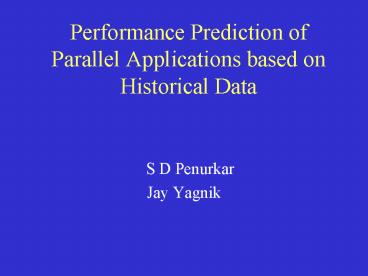Performance Prediction of Parallel Applications based on Historical Data
1 / 21
Title:
Performance Prediction of Parallel Applications based on Historical Data
Description:
Performance is the one which drives use of Parallel Applications (Vs sequential) ... Emulator is a program which emulates the application, hence dyanamic. ... –
Number of Views:27
Avg rating:3.0/5.0
Title: Performance Prediction of Parallel Applications based on Historical Data
1
Performance Prediction of Parallel Applications
based on Historical Data
- S D Penurkar
- Jay Yagnik
2
Topics Covered
- What is performance prediction and why we require
it? - Approaches to performance prediction
- Performance contract approach
- Prophesy approach
- Our ideas
- References
3
Performance Prediction Why?
- Performance is the one which drives use of
Parallel Applications (Vs sequential) - Since grids are basically widely distributed
collection of computers, there is
unpredictability of resource avaibility and their
performance . Hence certain guarantee of stated
performance is required.
4
Performance PredictionTypes and Parameters
- Types-
- Compute intensive applications
- Data intensive applications
- Parameters-
- No of computations
- Communication delays
- Processor load
5
Performance Prediction Approaches
- Model based
- Prediction based on historical data
6
Performance Prediction Model Based
- Mapping of application on to the computing
resources (network and processors) - Should include aspects of uncertainity inherent
in grid applications - Dynamic monitoring of resource performance
- Models help us to choose the mapping to produce
best throughput of the application
7
Performance Prediction Model based
- Trace from actual run
- Emulator
- Simulator
8
Performance Prediction Model based
- Trace obtained from single instance of
application and machine configuration - Static and can not reflect dynamic nature
- Emulator is a program which emulates the
application, hence dyanamic. - Simulator models the subsystems of parallel
machine at sufficient level of accuracy
9
Performance predictionComparision
- Analytical / Statistical
- Emulator
- Simulator
- Higher accuracy and more expensive as you
move from top to bottom. - More manual intervention down the line
10
Performance Prediction Performance Contracts
- Evaluation of expected performance in different
load conditions - 3 steps
- Application signature
- Executation signature
- Signature match and fuzzy membership
11
Performance ContractsApplication Signature
- Application intrinsic metrics
- solely depends on the application code and
problem parameters - expresses demands that application places on the
resources, independent of execution environment - Ex msg/ byte, flops
- Multidimentional with each application metric
12
Performance ContractsExecution Signature
- It reflects both the application demands on the
resources and response of resources to those
demands - Eg. instr/second , msg/sec
13
Performance Contracts Signature Match
- Project the application signature in execution
metric space using scaling factor for each
dimension and analyse
14
Performance prediction Prophesy Framework
- Main goal to automatically generate performance
models to aid in performance analysis
evaluation of given application - Data collection- using profiling and
instrumentation - Central databases- to collect performance info
generated during execution, to store model
templates and to store system charatreistics - Data analysis
- model builder produces analytical performance
models - Symbolic prediction
15
Performance Prediction Prophesy
- Uses 3 methods for performance prediction
- Curve Fitting
- Parameterization
- Composition method (analysis of kernel
interactions)
16
Performance prediction Prophesy Modelling
- Curve fitting
- Constructing functions whose graphs are the best
approx to collected emperical data points. Eg.
Linear, Exponential or polynomials - It uses only the emperical data
- It uses the least square fit when performing the
fit.
17
Performance Prediction Our Approach and
Required Infrastructure
- Use of Maximum available machines(20)
- Use standard benchmark scaLAPACK application
(eigen value) - Use of standard available profiling tool to
collect data ( PAPI) - Analysis of collected data and build prediction
model
18
Performance Prediction Some Ideas
- Use of uncertainty information in prediction
- Eg. Prediction Variance in Gaussian Process based
prediction - Selecting the curve type based on the observed
data points, and some criteria - Support Vector Regression may be useful
19
Performance Prediction References
- Valerie Taylor, Xingfu Wu, and Rick Stevens,
PROPHESY A Web-based Performance Analysis and
Modelling System for Parallel and Distributed
Applications, Performance TOOLS 2003 (Tool
demonstrations), Urbana, Illinois, September 2-5,
2003. - F. Vraalsen, R.A. Aydt, C.L. Mendes, and D.A.
Reed,Performance Contracts Predicting and
Monitoring Grid Application Behaviour, Grid
Computing - GRID 2001 Proceedings of the 2nd
International Workshop on Grid Computing, Denver,
CO, November 12, 2001,Springer-Verlag
20
Performance Prediction
- We believe that the most important open
question in performance today is how to assess
and verify the accuracy of performance models.
Without the means to assure the accuracy of
models , it is difficult to put them in
production use - ---------------- Toledo
21
Thank You































